|
Home
Fine China Tea Sets
Fine Porcelain
Furnishings
Silver, SilverPlate
Payment Options
Place an Order
Policies
Shipping
About Us
Book Shop
Collectibles
Search
Acclamations
Announcements
Glossary
Q and A
Restorationist
Favorite Links
Presentations
Requests
| |
|
Questions and Answers |
|
Welcome to our Q and A
which is in response to the numerous questions we receive on a daily
basis. Some of these inquiries result in fascinating and helpful
information that we think will be interesting to others.
These are only a few select samplings of what we receive.
Please note that as much as we would like to do so, we can't begin to post
each and every inquiry or answer each and every question. Thanks for
your understanding. Hope you find this helpful.
|
|
Notice |
|
All information and
pictures are protected under our copyright notice and may not be reproduced,
copied, or used by others without our prior permission. |
|
By your submission, you are granting us
permission to post and publish your questions, information, and pictures should we so
choose and as we so choose, whether in this format or other published
formats by Sharon Dickinson, unless you state otherwise at the time of your
submission. We protect your privacy by using your initials and general
location only. It is always interesting to know from what part of the
world the questions have originated. We enjoy hearing from all four
corners of the earth. |
|
|
|
|
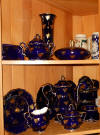

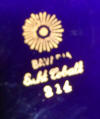 |
December 10, 2010
Q:
I have read your pages looking for the maker of the china I have inherited
from my mother and father. They were in Germany in the
early 1950's. My father was
in the Army at the time. The towns were still wore torn and ravaged by
years of war. My mother befriended a young woman,
Gertty, who was able to get my
mother a set of beautiful Rosenthal Cobalt Blue
china. I have the complete coffee set. I'm
curious about any more history on them.
B.G. in State College, Pennsylvania.
A:
Thanks for your very interesting e-mail
and beautiful pictures. The molds of your dishes, called
Pompadour, are certainly
Rosenthal and just like ones we had at one time, but in a different color.
What is puzzling to me is the lack of the Rosenthal mark on them. I'm
thinking that perhaps a decorating studio did the finished product, using
Rosenthal blanks and the starburst mark might be their mark.
I haven't been able to find the starburst mark anywhere, so can only
assume it might be the decorating mark. The lack of the Rosenthal
name or mark on them is probably what is making it difficult for you to
find anything.
I did find this which shows a sold set that looks nearly identical to
yours:
The link above may or may not hold. However, if you do some more
searches using Rosenthal Pompadour
or
Rosenthal Echt Cobalt, you
will come up with the some leads I found.
Thanks for sharing your fascinating family story.
 |
|
|
|
|


(In the event anyone out there recognizes the pattern
and/or knows of a resource for replacement pieces, please see our new
"Requests"
link for contacting KSH
directly.) |
April 10, 2010
Q:
I am trying to find 12 replacement saucers for this pattern. Do you
know the name of the pattern and/or where I might find the saucers?
The set originally belonged to my grandmother who went on a shopping trip
from her home in Michigan to New York City. That was sometime
prior to 1935. She purchased the
set brand new at that time. She passed them to my mother quite early
on, and I was raised with them at every holiday party and event you can
imagine. They are all beautiful. All of them ornate. I am
heartbroken that all 12 saucers have been broken. Can you help?
KSH of Santa Barbara, California
A: Your
dishes are beautiful, and your related family story is so very interesting.
As you know through our e-mails, we have both done exhaustive searches and
find nothing. From the marks, your grandmother no doubt purchased the
dishes from Ovington Bros., a
large retailer on Fifth Avenue in New York City.
They no doubt special ordered them from the
Aynsley factory in
Longton, England. This
Aynsley factory mark dates at least
to the 1920's. Your family
information serves as good documentation of this beautiful
Aynsley pattern (name unknown), the
Aynsley mark
of the 1920's, and this
Ovington mark of
pre-1935. Thanks for sharing your
story and pictures. Perhaps through this posting someone will be
able to help with the search.

|
|
|
|
|

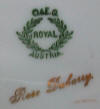
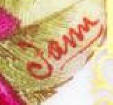


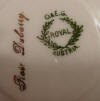



|
March 31, 2010
Q:
I have this beautiful large plate by O&E.G.
Royal Austria Rose Dubarry. The
story is that an elderly German neighbor gave this to my great grandmother
for being a good friend. I'm curious to know more about it, especially
the pattern. PT in Ninilchik, Alaska, USA
A: The
mark on your beautiful Rose Dubarry
plate is a factory mark for the brothers,
Oscar & Edgar Gutherz,
in business 1898-1918 in
the city of Altrohlau in what is now the Czech Republic
(see **** below for more
interesting Czech history).
With the end of World War I in
1918, the Gutherz
brothers sold out to a large conglomerate known as
EPIAG
(Source: Bohemian Decorated Porcelain
by Dr. James Henderson, p. 43).
During the years the Gutherz
brothers were in business, they manufactured the porcelain
and also decorated much of it. Royal
Austria was apparently a product line name and
Rose Dubarrry a pattern name.
According to Dr. Henderson, page 42,
Rose Dubarry was one of the several pattern names used by
Gutherz for their own
inside-the-factory decoration.
I'm glad you were able to find a signature on your plate.
Fann is one of the known
inside-the-factory decorators for
Gutherz.
I had a demicup with the same mark and decoration as your plate. I am
showing it at left just below your plate and mark. It, too, had a
signature (see saucer at left) which appears to be
Laporte, another known
inside-the-factory decorator for
Gutherz. Apparently both of
these pieces were decorated inside the
Gutherz factory, though I had
originally believed they were both products of outside decorators. Dr.
Henderson's book has enlightened me otherwise. The
Gutherz method of decoration was a
combination of transfers with handpainted touches.
According to Dr. Henderson, the result was "hand decorated transfers."
This same green
O.&E.G. mark, but without a pattern name was
also used as a whiteware mark (example below at far left).
Whiteware is the term for undecorated wares sold for
decoration outside the factory, including decoration in America. In
fact, Dr. Henderson's book, page 42, mentions that
Gutherz did export whiteware to America
and that much of it was "...hand painted by American decorating studios
or by individual artists."
Below left is just such an example of a truly handpainted and
signed plate that was
most likely the work of an individual American china painter by the name of
G. Hancock.
Therefore, there is no doubt this same green
mark without a pattern name was used as a
whiteware mark for decoration outside the factory,
but also used for
decoration inside the factory with a pattern
name added, as shown on the
Rose Dubarry items at far left above.
Thanks for sharing your beautiful
Rose Dubarry plate and family story
with all of us. I've enjoyed the research.

****Up
until 1918 and before the end of World War I,
Altrohlau was in Austria. In
1918, the end of World War I,
Altrohlau, now called Stara Role, became a part
of the newly-formed Czechoslovakia. Altrohlau
is the German name for the city; Stara Role
is the Czech name for it. In 1993, after
the fall of communism, Czechoslovakia became the Czech
Republic and remains so today. Altrohlau is
famous for its 12 hot springs and spas and is a suburb of the city of
Carlsbad (also known as Karlovy Vary). Both
Altrohlau and Carlsbad are in the western region of
the Czech Republic known as Bohemia. The
names Bohemia and Czech are interchangeble.
The entire region is in the Ore Mountains which is the home of
many Kaolin mines. Kaolin is an essential ingredient for
the manufacturing of hard paste porcelain. Because of the Kaolin,
there are many fine porcelain factories in the region.
(My primary source for this interesting information is
Sonia B., a native of the region
and whose grandmother and aunt worked in some of the factories in years
past.) |
|
|
|
|






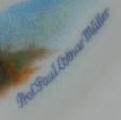
 |
March 9, 2010
Q:
My grandfather was a judge at the Nuremburg
trials (trial of the Nazi judges) in Germany. He was also chief
justice of the supreme court of Oregon, which probably helped make him a
candidate. Some time ago, there was a movie titled
"Judgment at Nuremburg" in which
Spencer Tracy played my grandfather.
The movie was a fictionalized version of the trials, so all the names were
changed. I have a copy of the book based on the movie with my
grandfather's signature.
During the time they were in Nuremburg
for the trials, my grandmother had time to shop. She brought back a
set of dishes for my brother and me. Upon close inspection, my guess
is that the decorations are decals rather than hand painted. They are
"signed" Prof. Paul Lothar Muller.
Any thoughts about these items. Thanks.
JA in Williamstown, Massachusetts, USA
A: This
is all so very interesting, especially about your grandfather having been a
judge at the Nuremburg trials.
Thank you for sharing your story and the pictures of your dishes. You
are most likely correct they are decals. It's not unusual for the
works of artists and their signatures to be reproduced on porcelain pieces
by way of decals. I've done some searching on
Paul Muller. He is a listed
German artist who lived 1869-1956.
I've actually found some of his oil paintings of
these same little characters in various settings that have sold at auction.
One oil painting sold for $911 on June 14, 2008, in Rudolstadt, Germany.
I have no other information on him. It should be noted that the
prices realized for his original oil paintings have no bearing whatsoever on
what dishes with his reproduced work would or would not bring.
The Thomas mark is the
factory mark for the
F. Thomas
Marktredwitz Porcelain Factory
of Marktredwitz, Bavaria, Germany.
You probably already know
that the U. S. Zone part of the mark
dates the pieces to the years 1945-49
when Bavaria Germany was occupied
by the U. S. Military. In
searching about the Nuremburg trials, I
learned they were held in 1948 "in an
American court inside the occupied zone of Germany."
The city of Nuremburg is
located inside the area of Bavaria, the
1945-49 U. S. Occupied Zone.
In summary, your set was manufactured sometime between
1945 and probably 1947.
Assuming
your grandmother didn't travel outside Nuremberg
to shop, she no doubt purchased it brand new in a
Nuremburg shop in
1948.
They represent an important and interesting part of your
family legacy.
Thanks for allowing me to share your interesting story
with others.
 |
|
|
|
|

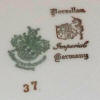 |
February 20, 2010
Q:
I really enjoyed your site and the extensive research you've done on the
marks. I have one that really puzzles me.....I was wondering if you
can tell me anything about the possible year or anything about the gold
mark. I have always liked this plate, but have never been able to
pinpoint when it was made or by whom. I think by reading your
site it was quite possibly made by Christopher
Schumann of Schumann & Schreider. Can you help??
SR in Santa Fe, Texas, USA
A:
The green mark is a factory mark for
Schumann & Schreider in Schwarzenhammer, Germany. The
factory was founded in 1905 by
Christopher Schumann and his
father-in-law, Karl Schreider.
The gold mark remains a puzzle. It may be a decorating mark, but I
haven't found it in any of the many reference books I have. I've added
it to my table of
fine porcelain marks
in the "Unidentified" section.
The date of your plate is
c.1930's. Thanks for writing.
If
anyone knows this Porzellan Imperial Germany
mark,
please e-mail.
 |
|
|
|
|

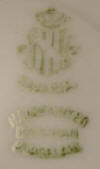
 |
July 11, 2009
Q:
I was wondering what you can tell me about this mark. My grandmother
recently gave me her chocolate set which is over 100 years old.
She received the set from her aunt, but doesn't know when or where her aunt
got it. I have been unable to find anything similar to the mark until
I found your website. If you could be of any help, I would greatly
appreciate it!! B.S. in Yankton, South
Dakota, USA
A: From
what I finally found in a book of marks from Germany, that particular mark
with only the word Bavaria is
shown as c.1903-1930.*
So, your set could very well be over 100 years old as of 2003. It is
from the Porcelain Factory Tirschenreuth
in Tirschenreuth, Bavaria, Germany.*
*(Source:
Keramik-Marken Lexikon, 1885-1935,
by Dieter Zuhlsdorff, page 271)
It is handpainted as indicated in the mark. From that,
I assume it was decorated in the factory's own studio. Though artist
signed, I can't quite make out the name. The mark is also hard to
read, but it says PT Bavaria, Handpainted
Bavarian Porcelain.
Thanks for sharing your pictures and family story.
 |
|
|
|
|




 |
April 21, 2009
Q:
I recently purchased this set at an auction in Rock Springs, Wyoming.
I have found countless Rosenthal sites and can't gather any information.
There is a small piece of paper with limited writing which says this was a
wedding gift on September 1, 1892.
It also states they are a beer pitcher and four mugs. Do you have any
knowledge about this set? M. W. in Wyoming,
USA
A: You
have a very beautiful set and an excellent deal at the price you stated
privately. The notes on the pieces are recent, so the information was
obviously passed down -- I was so hoping to have seen some very, very old
notes and writing. Based on the mark, the set does not go back to 1892
unless the reference books are wrong. Every book of marks that I've
searched puts this particular mark as no older than
1907 and apparently in use until the
1930's.
The
Rosenthale mark with the e
at the end is a whiteware mark for
Rosenthal, which means your set is most likely hand painted.
In fact, from studying the pictures, I am quite certain it is hand painted
and most likely the work of an American china painter. The
pieces
are,
however, unsigned since you have determined there is no signature present on
any
of
them.
Your set is referred to as a
Tankard Set. Webster's defines tankard as a tall
drinking vessel, the assumption being on my part that it can be used for any
beverage of choice -- lemonade, tea, etc. Based on the Art Nouveau
style of the flowers and leaves, I think it is quite possible that the set
might have been decorated around 1910
or possibly into the 1920's.
My sources for the dating of the mark include:
(1) New and Revised Edition of
Directory of European Porcelain by Danckert, pages 12 and 597.
(2) Keramik-Marken Lexikon by
Dieter Zuhlsdorff, page 263.
Thanks for sharing your information.
 |
|
|
|
|
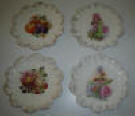
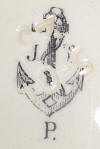 |
May 25, 2008
Q:
Could you please help me? I received four porcelain plates as a gift
several years ago, and I tried to find where they are from (factory,
country, years, etc.). I asked many people and checked many books
about porcelain marks and still do not have the answer. I truly
appreciate your time. Thank you very much.
Svetlana and Troy, Michigan, USA
A: I
cannot find your mark anywhere, and I've consulted several good books.
It is similar to the Davenport
marks, a ceramic factory in Longport, England,
1793-1882
(Source:
Directory
of European Porcelain by Danckert,
page 234). The Davenport
marks, however, do not include the J.T.P.,
so this mark still remains a mystery.
Also similar to marks by
Porsgrund Porcelain Factory of Porsgrunn, Norway, but still not
the same.
I'm posting your pictures here and requesting anyone out there who might
recognize it to please
e-mail
me, in which case I will update this posting. Thanks
for writing.
 |
| |
|
|



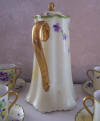


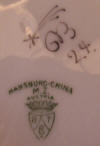 |
April 2, 2008
Q:
I ran across this complete and unblemished chocolate pot with six cups and
saucers from my mother's estate. The mark is
Habsburg China, M. Z. Austria, and a cursive
GB 24. The set has been
packed away forever as far as I know, and I believe it originally belonged
to my great Aunt Clara. Can you tell me anything else about it?
SS in Davenport, Iowa, USA
A:
I have been studying your pictures
and mark and had almost given up on finding the mark. I finally found
it, along with some very interesting information, in a great book called
Bohemian Decorated Porcelain by
Dr. James Henderson,
pages 82, 83. It's
rather complicated and has been educational for me. Here is the
breakdown as best I can interpret what I found.
The mark is for Burley & Tyrrell
(the B T in your
mark) of Chicago who were
wholesale and retail distributors of Bohemian porcelain. They were
brothers-in-law in business together (and later with a nephew) and were
known by that name, Burley & Tyrrell,
in 1871 following the Chicago
fire. They started importing and distributing Bohemain porcelain
around 1880 and eventually
operated a decorating studio above their salesroom in
Chicago. The mark on your chocolate set was the
only mark used by them and was used c.1890-1919.
In 1919, Burley & Tyrrell
was bought out by a competitor. In the meantime, a nephew,
Frank Burley, had come into the
picture in 1883 whereby another
name was created, Burley & Co.
(the Co. part of the mark on your
set). Burley & Co. was
known to have been retailers as
well as china decorators from
1885 to 1931 when they closed.
Apparently the Burley & Co. part
of the business continued with the decorating studio even though the
Burley & Tyrrell branch was sold
in 1919.
Hapsburg China
(as on your set) was the name used for
distributing china produced by the
Moritz Zdekauer factory (the
MZ Austria mark on your set).
Here's what I believe about
your chocolate set:
I believe the undecorated pieces (whiteware) were produced by
Moritz Zdekauer and
imported to
Chicago by Burley & Tyrrell
prior to 1919 (when they were bought out),
decorated in 1924 by
Burley & Co. (the studio that
continued on until 1931), and eventually
distributed under the Hapsburg
China name.
I believe the GB
and the number
24 on the
bottom of your set is a signature and a date. The
GB could be a
Burley --
a Burley family member who worked
in the decorating studio and decorated this set in
1924. Remember, the decorating studio didn't close
until 1931. Undecorated whiteware can linger around for years before
anyone gets around to decorating them.
Back to the GB,
there is an Arthur Gilman Burley
in that family history -- GB
could have been a descendant named Gilman Burley
after his ancestor. This is just my speculation, but seems logical.
I'm wondering if your Great Aunt Clara or any of your family members lived
in the Chicago area since that is where the set originated.
In subsequent e-mails with you, you have confirmed that you
believe your Great Aunt Clara most likely purchased it in the
1920's when she was in her
twenties and could have easily made trips to Chicago related to her many
activities as an advocate for women's rights. You also shared that she
was a school teacher and a homemaker and took great pride in her house and
garden. She obviously had wonderful taste to have purchased this
beautiful chocolate set. Thanks so much for sharing.
 |
| |
|
|
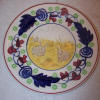
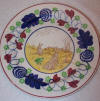
 |
March 6, 2008
Q:
I have inherited some plates and am interested in the history of them.
They have a handpainted border of red and blue flowers and in the center are
rabbit families. Some have a frog with the rabbits. Could you
tell me anything about them. They do all have crazing, and I think
they are quite old. They came from a great aunt to me, and to her from
an aunt as far as I know. I believe the plates came from New England,
as my aunt lived in Maine, Massachusetts, and New York.
DB, Mt. Vernon, Ohio, USA
A: I have
no idea what the unusual blue mark is, but I agree with you that they are
quite old and possibly very special. In the picture of the backside
with the mark, I can see the consistent crazing all over, which sometimes is
a sign of a very old age. The fact that they are handpainted, have the
beautiful cobalt blue, and the cute rabbits, all contribute to their
desirability.
I'm posting this with the hope that someone out there might
recognize the mark and even the plates. If so, please
e-mail
us with any information you might have, and I'll update this accordingly
with proper credit to the contributor.

Update: April 3, 2009
Here is a link that identifies this as transfer tableware
known as "Rabbit
Ware":
Green Castle Museum
As you will read on the Green Castle
website, Rabbit Ware is costly and
difficult to find. As for the porcelain factory that produced it, that
is not mentioned, so the porcelain mark continues to be unidentified.

|
| |
|
|


 |
March 4, 2008
Q:
I have enjoyed consulting your website and now I am asking if you can
identify this porcelain butter dish which is unmarked. RS Prussia and
Limoges books have been consulted without success. Thank you.
CB in Canaan, New Hampshire, USA
A: I keep
going back and looking at the pictures of your beautiful butter dish, but
just can't identify it at the moment. You've already consulted the
same books that I would have. With your permission, I am posting it
here as an unidentified item with the hope that someone else might be able
to identify it and send me an
e-mail. If so, I'll update
this posting accordingly. Thanks for writing.

 |
| |
|
|
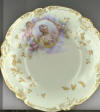
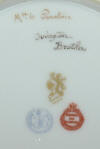 |
February 13, 2008 Q:
I have this plate that I cannot trace. The portrait
is of Madam Parabere, and it
appears to be hand painted. The plate came from my deceased aunt
and it was in a box with other china. She did travel extensively in
the 1960's. It may have belonged
to her husband's family, but I'm not sure. Any information you can
offer is welcome. M.A. in Williamstown,
Massachusetts
A:
As you have already stated, the portrait is that of
Madam de Parabere. Her name
is so inscribed on the back of the plate. The
gold used for her name seems to match the
gold of the as yet unidentified mark of
the "Paris Gold Knight." The
blue circled mark says
Sevres 1844, and appears to be a
genuine Sevres mark. I believe this plate left the Sevres factory as
an undecorated whiteware piece and was decorated later in the
"Sevres Style." The red mark says
Chateau
Des Tuileries and is most likely
that of a Limoges
or Paris
decorator. (A similar mark is
shown on page 395 of Gaston's Third Edition Limoges
book, except it is Chateau De St. Cloud.
It
is referred to as an overglaze decorating mark and dated c.1905.)
The as yet unidentified
"Gold Knight Paris" mark seems
familiar, but haven't been able to find it in any of my books. Please
e-mail if you know. The final
mark is that of the Ovington Brothers
who were retailers in New York and Chicago. The assumption
is that the plate was made for them.
Thanks for sharing your plate. I'll post any updates
should anything else surface. Please do the same.
 |
| |
|
|


 |
January 31, 2008
Q:
Would you have any information regarding some
Rosenthale Selb-Bavaria Donatello dessert plates? When
my grandmother and grandfather married in 1937,
my grandmother was given the plates by a couple of elderly sisters that
lived down the street from her. The sisters told her they had been in
their family for sometime. The plates now belong to my mother, and she
has always been interested in finding out any history on the plates or
designer. My grandparents lived in
Saginaw, Michigan. Thanks.
TS in Baldwin, Wisconsin, USA
A: It
appears that your plates are the work of a china painter by the name of
Marie (most likely an
American china painter). Notice
her name in the picture you sent of the backside. You have confirmed
through additional e-mails we've exchanged that all of the plates are signed
Marie H. Marie
was most likely an ancestor of the sisters who gave the plates to
your grandparents in 1937.
The Rosenthale mark (with the
e at the end) is
the whiteware mark for the
Rosenthal factory of
Bavaria, Germany. Rosenthal was one of
the major producers of whiteware
used for decoration by independent china painters, especially in
America.
Donatello refers to the name of the mold (shape/design)
of the plates. What an interesting family history you have connected
to the plates. Thanks for allowing me to share it with others.
 |
| |
|
|


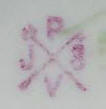 |
October 19, 2007
Q:
I purchased three pieces of china at an estate sale. I cannot find the
mark. Your website is just wonderful, and I had hoped I would find
this mark so I would know what it is. The only piece that is marked is
the creamer. The bowl is just lovely, but unmarked. Any help
would be so appreciated. Thanks. RP
in Asheboro, North Carolina, USA.
A: I
agree that the pieces are very beautiful.
The mark
is that of the Johann Seltmann Porcelain Factory
of Vohenstrauss, Bavaria, Germany, and is dated
c.1901-1932
(Rontgen's, pages 60 and 377).
In looking at your pictures, I believe what you have may be hand painted and
probably by an American china painter. Since only the creamer is
marked with a factory mark, it appears that the painter used an assortment
of blanks to produce the matching group, only one of which was from the
Seltmann factory. Through
additional e-mails, you have confirmed to me that you find no signature.
I have seen several hand painted items that were not signed for whatever
reason. Thanks for sharing the pictures.

 |
| |
|
|


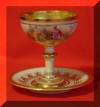
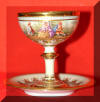 |
August 23, 2007
Q:
Would you know anything about these pieces? They have a lamb on the
bottom and another mark that appears to have been covered up. I
believe they were made around 1895
for George Eastman of Eastman Kodak
fame as a wedding gift for the daughter of a friend. The Eastman
connection comes from the fact that a fellow named
George Sage, who was one of the four original investors
who put up the initial money to get Eastman started and was very close to
Eastman, had a daughter named Alice Sage,
who became Alice Sage Cole (the
monogram on the plates is ASC).
Alice Sage Cole was my
ancestor and this is the story that has been passed down through the family.
The entire set consists of 12 place settings of 6 pieces each (72 pieces
total), all pristine having never been used. Any information would be
much appreciated. Lou Ann in Denver,
Colorado
A: The mark that
is covered up is a factory mark for the Silesian Porcelain Factory
that produced the undecorated whiteware. The lamb mark is a decorating
mark for Ambrosius Lamm who had a
decorating studio in Dresden, Germany,
and used that particular mark c.1891-1914,
which is compatible with your family history. It was common
practice for some reason for the decorating studios to cover up the factory
marks. The "Dresden Porcelain Studios"
book by the Harrans (can be found
on Amazon) mentions the Silesian Porcelain Factory as being
one of the sources for blank whiteware used by
Lamm. Also in the Harran
book are several pages of beautiful items produced by the
Lamm studio, including examples
of goblets very similar to yours. What a great treasure you have as
well as a nice family connection back to
Eastman. In subsequent e-mails we've had, you've told
me these beautiful treasures will not be going back to the attic where they
had been stored for years, but will be going into a new china cabinet since
you now know what you have!! Thanks for sharing a part of your family
history with the rest of us.
 |
 |
 |
 |
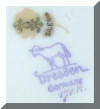 |
 |
 |
 |
 |
| |
|
|


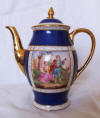

 |
June 13, 2007
Q:
I have a Bohemia Ceramic Works
tea set, gold plated, in original box. I genuinely don't think it has
ever been used. It has an electric blue
background with an artist's impressions of young girls being serenaded by
young men. I would describe it as being in perfect condition.
All six cups are gold plated, and there is no wear on any of the items.
The box is a little worn, but I'm sure I could have that reconditioned if
necessary. What is curious to me is how the
BCW logo has been stamped over with a
Carlsbad Fine Porcelain logo.
I've had the set for 25 years, and before that it belonged to my
grandparents. It has probably been in the case for the last 50 years.
My grandfather was from Breslau
which was in the former Czechoslovakia.
I'm not sure if he got the set through his family line, or if it came
through my grandmother's side whose ancestor was an
English 1820 settler to
South Africa (one of the first big settler groups). My
grandfather was a supreme court judge, and my grandmother was an advocate
(in the 1950's) in Pretoria, South Africa -- so they were both well-to-do.
Maybe it was a gift, as my grandmother legally represented the foreign
embassies in South Africa. Can you tell me anything about it?
Donna in South Africa
A: The set is
beautiful. Rather than a tea set, what you have appears to be a coffee
set. The pattern you have is the Love
Story (referring to the figural scenes). The
green Bohemia Ceramics mark is
the manufacturing mark of the
factory that produced the undecorated wares. The
Carlsbad mark is the
decorating mark of Friedrich
Simon who had a decorating studio in
Carlsbad from 1920-1931. He was known for
decorating whiteware from Bohemia Ceramics.
(Source: page 56 of Bohemian Porcelain by
Henderson). Therefore, based on the
Carlsbad Fine Porcelain mark,
your set dates back to c.1920-1931.
It was common practice for the decorating studios to overstamp the factory
marks, which is why you see his mark over the
Bohemia Ceramics mark.
You mentioned reconditioning the case -- don't do a thing
to it. A little wear can be a good thing. Obviously the set has
been treasured and protected through the years, and everything should be
kept exactly as it is. Thanks for writing and sharing your pictures
and related family history.
 |
| |
|
|
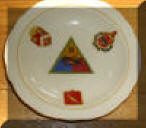 |
June 1, 2007
Q:
Good day. We found among my late uncle's estate items a small plate
with military emblems and a crest on it and marked on the bottom with two
Schumann Bavaria marks.
This might have been given to his regiment by the
King (or Prince) of Belgium. My uncle who was a
U. S. Army soldier during
World War II and fought in
Germany, Normandy, and Belgium. He
was in the 16th Field Artillery Regiment, 3rd
Battalion, 3rd Armored Division. They were recognized
by Charles, Prince of Belgium,
Regent of the Kingdom, for two famous battles in
Belgium and were awarded a
citation called the Belgium Fourragere
in November 1945. I think
this might have been part of that recognition. I've already
interpreted some of the emblems and am wondering if you might have
additional information. It's 5 1/4" diameter and my uncle
used it for keeping his ring and watch.
Jude in Sedona, Arizona
A: This is the
first one of these to come my way, and I am so pleased to have it.
Thank you for interpreting some of the symbols which I am displaying below.
As to the other symbols, I'm hoping someone out there might recognize these
and
e-mail me,
in which case I'll update this posting. As for the
Schumann connection, it appears
that someone, perhaps the American Military,
perhaps the Belgian government, commissioned the Schumann
factory to make these for each member of your uncle's
regiment. Unless there is some reference to
Belgium in the symbols, we can only speculate as to the
occasion that generated this commemorative dish. It seems logical
that Schumann was the chosen
factory for this special order. Carl
Schumann II was a great friend of
America and of our military, especially during those years
just after the end of World War II. It would not be surprising at all
if perhaps he might not have charged for this particular order. He was
very generous, and this could be another
example of his generosity. Thanks for sending these pictures and
sharing such an interesting part of your family history. I'll update
this posting if new information surfaces.
 |
|
 |
|
Shield
mark is whiteware manufacturing mark.
Crown
mark is decorating mark. |
|
 |
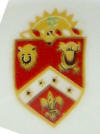 |
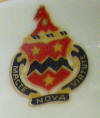 |
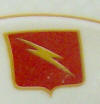 |
|
Shoulder patch for the
Army's 3rd Armored Division. The
9 at the top is the
Division Number. The
red represents
Field Artillery; the
Blue represents
Infantry; the
Yellow represents
Calvary. In the center is
the running track of a tank and a cannon. |
Coat of Arms
with Lions Heads
E-mail if you can interpret meaning. |
Horse head
crest with the motto for the
16th Field Artillery Regiment,
"Go Forth with Strength." |
Red patch
with gold lightening bolt
E-mail if you can interpret meaning. |
| |
|
|
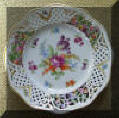 |
April 5, 2007
Q:
I am extremely interested in your Schumann
research. Dad was in the Air Force and stationed at Rhein-Main
Air Force Base in Frankfurt, Germany, in late 1947.
Mom was already expecting me and sailed by boat to Europe to
join him in early 1948. She was only 21, an only child,
had never been outside the South, and was truly pampered. After I was
born, Dad was able to secure a very lovely three-story home which was much
too big for just a wife and new baby. There was a tremendous housing
shortage at that time, and the German government paid anyone who would allow
German citizens to live with them. In turn, the citizens helped out in
the household. That worked out beautifully for my Mother who was
completely out of her element. As time went on, Dad decided to build a
garage with additional housing over the garage. Upon digging the
foundation for the garage, a large crate of china was discovered.
Among the items in the crate was Schumann
china, as well as some that looked like Schumann
but with different markings. My question is, do you recognize the
look-alike china? Unfortunately, there is very little left of what was
found in the crate. We continued to be transferred for the next 18
years, including a second tour of duty in Bittburg, Germany
(1955-1958). Many pieces were damaged or lost in moves, but
the biggest devastation happened when we were in Anchorage, Alaska,
and the Big Earthquake hit on Good Friday, 1964.
I've had a very interesting life, and the family was always able to be with
Dad wherever he was stationed. I currently live in Atlanta,
Georgia, my parents home before and after the service.
A.A., Atlanta, Georgia, USA
A:
Your story
is so very interesting and thank you for sharing it. Both of your
pieces are decorated with a version of the famous
Dresden Flowers, which were used by various
factories for decorating their china, but each with its own pattern name.
The Schumann plate you have is
what came to be called Dresden Line,
similar to Chateau Dresden.
Both of these Schumann patterns
have reticulated (pierced) rims, but the difference is in the decoration --
the Chateau rims are much more
highly decorated with the flowers. The
Dresden Line rims have more white, as does yours, because
of less flower decoration. The look-alike china, also decorated with a
version of the Dresden Flowers,
is from Oscar Schaller & Co. of Kirchenlamitz, Bavaria, Germany, in
business 1921 to the present day as part of the
Winterling Group. The exact name Schaller may
have given this pattern, I don't know. I think you already know that
the Schumann mark dates back to
1924 and into the
1930's. Certainly, they are
all pre-war, based not only on
the marks, but the fact that your Dad found them buried in Bavaria.
That was done by the original owners to protect them during the war.
Thanks again for sharing.
 |
|
 |
|
 |
|
 |
| |
|
|
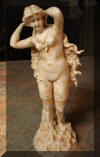 |
December 19,
2006
Q:
I have a figurine I purchased and was trying to find out the maker.
Can you help? Your listing of marks is very helpful, and you have my
permission to add this one.
A:
Your statue
was made by the New York & Rudolstadt Pottery
Company of Rudolstadt, Thuringia, Germany, in business
c.1882-1918. Your particular mark
was registered May 2, 1896, in
the German Trademark of Registry. The factory was owned
by L. Straus & Sons in New York
who were U. S. importers.
So, your statue was made sometime between the years of
1896-1918. Thanks for
sharing.
 |
|
 |
| |
|
|
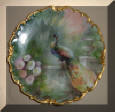 |
August 28, 2006
Q:
First, thank you for such a great website!! Second, I have been trying
to find out more about this plate I inherited. I don't know where it
originally came from, but remember it always being around. My
Grandmother came from England to the U.S. in 1923 with my Mother who was 3
at the time. She lived for years in Brooklyn, New York, and worked in
both Brooklyn and Manhattan. This plate may have been included in some
of the things she bought from her employer who downsized and offered
his employees the opportunity to purchase. It is 10 1/2" diameter and
pierced on the back for hanging. I plan to hang it back on the wall
for the next generation to inherit. In the meantime, thanks for any
information you may be able to give me. I visit your website often and
thought I'd take a chance on e-mailing you about this.
J.K., Indianapolis, Indiana, USA A:
So glad you
decided to e-mail me about this gorgeous plate. It was hand painted by a
listed Limoges artist, J. Soustre,
whose name I found on page 456 of Gaston's Third
Edition book on Limoges. Gaston's book
shows an example of Soustre's work on a whiteware blank
produced by Haviland, 1888-1896. Your plate is a whiteware blank produced by a Limoges factory after 1891.
As to exactly when Soustre
did his/her work is not known. The whiteware blanks could have
been in existence years before they were decorated. Since
Soustre obviously used whiteware
blanks from more than one source, he/she was most likely an independent
artist who worked for several factories and studios. According to
Gaston, these details are just not known about most of those artists.
The other mark, A. Gottlieb, New York,
may have been a department store in New York City, or at the very
least an importer or distributor of some kind. I find no references so
far on that name. Will update this listing if any other information
surfaces. You are doing the right thing to hang it back on the wall
for the next generation. Thanks for sharing it with us.
 |
|
 |
|
 |
|
|
|
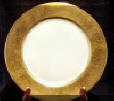 |
June 17, 2006
Q:
Good morning. You have a wonderful and very informative website,
but I find no mention of Edgerton. My Dad bought this plate from a couple in the 1960's. The
Schumann mark appears to be
1918. Is that correct?
Was Edgerton the importer or the
decorator? I've bookmarked your site and have learned what to look for
on Schumann pieces. Many
thanks for your help. A.B., Steeleville,
Illinois, USA
A:
That would be the decorator. As soon as I saw your
pictures, I recognized the plate to be Pickard,
so I went to my Pickard book
immediately. Sure enough, the Edgerton
mark is one of the decorating marks used by
Pickard China, a decorating studio in
Chicago, Illinois. Your particular mark is dated
1928-38. Pickard
was known for his beautiful etched gold designs. He was originally
from Edgerton,
Wisconsin, and had connections
with The Edgerton Art Studio
which eventually closed shop. The name
Edgerton went with him as one of his trademarks when he
established himself in Chicago.
Pickard imported china blanks for
decorating, but mostly Limoges blanks (according to the
Pickard book noted below).
It is interesting to see that yours is German
whiteware since it is from the Schumann
factory of Arzberg, Germany.
You are correct that the Schumann
mark dates back to c.1918.
Schumann closed its factory in
1994, but
Pickard is still in existence today in Illinois.
Here's a link to current information about
Pickard:
http://www.pickardchina.com/About_us.htm
My source for the Pickard/Edgerton
information is
Collector's Encyclopedia of Pickard China
by Alan B. Reed, page 12.

|
|
 |
|
 This serves as evidence that this
particular old blue Schumann
mark was used on whiteware (undecorated
blanks) exported from Germany to America in the early decades of the 20th
century. |
|
|
|
 |
March 22. 2006
Q:
I have a set of Limoges china that I believe to be very old.
It is a place service for 12 with all the serving pieces. I would
appreciate it if you could help me with some information on this particular
pattern and age. There is no pattern number or any information except
the emblems on the bottom of all the pieces. All the websites I've
gone to ask for a pattern number or a date line in order to find where they
might start to look. Do you have any information on my set?
Thanks for all your help and support.
Jules
A:
The set is beautiful and you are correct that it is very old.
The marks are for W.G.&Co. (William Guerin & Co.), Limoges, France,
and are dated c.1900-1932. The dark mark
is a factory whiteware mark for Guerin.
The red mark is their own
decorating mark. What that means is your set was
manufactured by and also factory decorated by
Guerin somewhere in those years of 1900-1932.
I've just looked through the Guerin section of Gaston's Limoges
book and didn't find a picture of your exact pattern, nor did I see
pattern names for those that are pictured. Chances are, your set was
never given a pattern name.

|
|
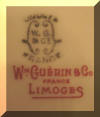 |
|
My source for the dating of
the marks is Collector's
Encyclopedia of LImoges Porcelain, Third Edition,
by Mary Frank Gaston, page 134. |
|
|
 |
March 8, 2006
Q:
My inlaws gave me three pieces they say are over 40 years old -- one bowl
and two candlesticks. They may have been purchased as a set of three
pieces. Can you help me determine if they are truly Dresden porcelain?
I would be grateful for your help. R. &
S.K., Petaluma, California, USA. A:
I do believe the marks are genuine and that the pieces
are from the Von Schierholz Porcelain Factory of Plaue,
Thuringia, Germany. What you've been told that they are over 40 years
old agrees with the dating of the mark as being 1951-1972.
(Source: Marks on Germany, Bohemian, and
Austrian Porcelain by Rontgen, page 88).

|
|
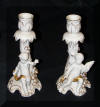 |
|
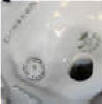 |
|
|
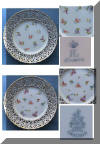 |
March 4. 2006
Q:
We have some 7" reticulated dessert plates with marks that so far no one has
been able to identify. Would you please take a look to see if they
ring a bell. D.B., Fayetteville, Texas,
USA
A:
I wish I could say that they do ring a bell, but
they don't other than being somewhat similar, but not the same, as others
I've seen. They are obviously German. The RL
mark is most likely from an old decorating studio in
Dresden, Saxony, Germany.*
The Saxonia mark is probably from the porcelain factory that
produced the whiteware. I've checked several good books on
marks, as well as on Dresden, and nothing. It's possible they were
small, independent operations and just never documented in current reference
books. As we agreed, I'm posting your pictures with the hope
that someone out there might be able to identify them and
e-mail me.
If so, I will add an update to this posting.
*Dresden
is a city in Germany and Saxony is a state.
Here is a link to some historical information about that part of the world:
http://en.wikipedia.org/wiki/Saxony
 |
|
 |
|
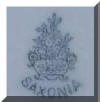 |
|
|
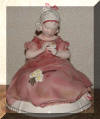 |
February 19, 2006
Q: We have a piece of china that has
been in the family for 50 years. I can remember being told it was
Dresden. However, I cannot identify it with any Dresden marks I have
seen on the internet. My Grandmother was given the piece by a family
friend for helping to nurse her through a long illness. The family
friend had been given the piece by a brother who had brought
it back from Germany. One account says that he was a
soldier in the 1914-18 World War I. I don't
know if this is true. My Grandmother was born in 1885,
and she and her friend would have been in their early thirties
in 1918, so it is possible. I would appreciate any
information you can give me.
J., Lancashire, United Kingdom
A:
Although it is of German origin, what you have would not be
called Dresden. It is from the Hertwig &
Co. Porcelain Factory of Katzhutte, Thuringia, Germany.
Among other things, they were known for making figurines and dolls.
The mark is dated c.1914-1958, so
that appears to agree with the history of the piece as you have been told.
As to what the O in the mark
means, I don't know.
 |
|
 |
|
My source is
"Marks on German, Bohemian, and
Austrian Porcelain" by Robert Rontgen,
pages 49 and 426. |
|
|
 |
January 23, 2006
Q: I'm wondering if you can help me with
a porcelain tea or coffee or chocolate set -- I'm not sure what to call it
(unfortunately, there are no cups and saucers or any other pieces).
I know it came from Germany around the 1880's because it was my great
grandmother's wedding present. They immigrated to Canada where my
grandmother was born in 1885. According to my grandmother, they
brought this set with them , as well as a few other items, including an
old leather-bound German Bible. There are no markings on the
pieces that I can find. I have been looking all over the net for
something similar, but can't seem to find it. Thank you in advance for
your help. K.S.K.,
Rochester, New York, USA
A:
What you have is generally referred to as "Old Nippon"
which means it is of Japanese origin prior to 1921 -- Nippon is another
word for Japan. Based
on your family history, your particular set was obviously manufactured well before
(pre-1891)
what came to be known as the "Nippon Era" which were the years
1891-1921. Beginning in 1891 (in compliance
with the McKinley Tariff Act which required that countries of origin
be marked on items coming into the USA),
"Nippon" was marked on items exported from Japan for
the U.S. market. The "Nippon Era" ended in 1921 when the U.S. government
decided that "Japan" was the English equivalent of the Japanese
word "Nippon"
and
that all items
henceforth coming into the U.S. from there should be marked "Japan."
It should be noted that many unmarked items still made their way into the
U.S. for various reasons; for example (1) not all pieces in a set
were necessarily marked because of the labor costs involved in marking each
and every piece; and (2) many unmarked items were brought in
through private means such as your great
grandparents having moved from Europe to Canada and then the items being
passed down to family members in the USA.
Your set, however, was unmarked because we know it already
existed prior to the marking requirements. Your family
history agrees with the history of Nippon/Japan's opening up of trade with
the rest of the world. It appears that they were exhibiting their
porcelain wares as early as 1862 in London, 1876
in Philadelphia, and 1878 in Paris. Thus, your great
grandparents' wedding gift most likely found its way to them in Germany by
way of London or Paris or similar routes.
What you have is a wonderful family treasure and you
should document in writing as much as you can about its origin as well as
any other family history of which you have knowledge. Be sure to sign
and date your own documentation. Thanks for sharing your family
history about this beautiful set.

|
|
Old Nippon mixed set with hand painted
Florals and applied gold decoration |
|
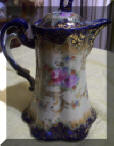 |
|
Chocolate Pot |
|
 |
|
Teapot |
|
 |
|
Sugar and Creamer |
|
For more indepth information about
Nippon, refer to
Joan F. Van Patten's
series of books entitled
Collector's Encylopedia of Nippon Porcelain.
Her
books and many others can be found on
www.collectorbooks.com. |
|
|
 |
December 10, 2005
Q: I have a beautiful ES Prussia
plate that I am trying to identify the mark and age. Anything you can
do to help would be appreciated. I just couldn't pass it up at an
antique store recently, even with a tiny chip on the rim. Does the
chip devalue it? I love anything with pink roses and this is a
beauty for sure!! S.B., Camden, Michigan,
USA
A:
I agree -- what a beautiful plate!!
Roses are my favorite also. This
PROV
SXE mark is dated to the 1920's and is from the
Erdmann Schlegelmilch factory of Suhl,
Thuringia, Germany (Source: Collector's
Encyclopedia of R. S. Prussia by
Mary Frank Gaston, page 215). Yes, the chip devalues it considerably,
but since you "bought it right" (as we discussed
through additional e-mails), you have room for a
professional repair if you wish. Otherwise, you can just display the
plate in such a way in your cabinet that the tiny chip would not be
noticeable.
 |
|
 |
| |
|
 |
December 9, 2005
Q: I just
bought this set of Victoria Austria covered bowls and saucers
from an estate sale and need to know more about them. I figured
you would be the person to ask. The mark on the back reads
Victoria Carlsbad Austria. Some of the pictures have a
signature; i.e., Ferrier and Berger. There
are four different Napoleon pictures and scenes between the 8
bowls and saucers. I haven't been able to find anything like
them on the internet and don't even really know what to call them. Any
ideas? C.M., Virginia, USA
A:
What you have are covered bouillon cups. If taller and slimmer, they
would be covered chocolate cups. You have confirmed for me through
additional e-mails that the pictures and scenes are all in transfer, rather
than hand painted, as I suspected, in which case the signatures are
reproduced also. The mark is dated 1891-1918 and
is from the
Victoria Porcelain Factory
of Altrohlau, Bohemia (now
Czechoslovakia),
in business c.1883-1945 under the ownership of Schmidt &
Co. (Sources:
Page 59 of
Kovel's;
and page 17 of
Directory of European Porcelain by
Danckert).
See our Glossary
under Altrohlau, Bohemia, and Czech Republic for
some historical information about this region.
I also have come up with nothing in searches for similar
items.
I'm asking anyone else out there who might have
additional information or have found anything comparable to these, to please
e-mail me. I will credit you accordingly in an update to
this posting.
 |
|
 |
|
 |
|
 |
|
According to the
resources, this mark is believed to be the oldest one used by this factory. |
| |
|
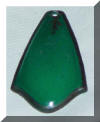
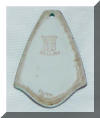 |
June 11, 2005
- Mystery Schumann Item - Solved
(see September 28, 2006 update below)
Q: I
viewed your website looking for information on an item that has the
"Bavaria Schumann" mark in gold print. It is a green, almost
triangular, pendant. I don't find anything like this made by Schumann.
My daughter thought it might be the inside of a bell ringer. It was
found in my mother's jewelry box. I know she had an older friend who
moved here from Germany before the War (WW II). Can you
enlighten me? M.J.S., Northern Illinois,
USA
A: I've
not seen anything like this. Notice the worn and soiled edges on the
backside where something was attached to it at one time, perhaps a metal
trim. The shape of it and the hole in the top for a hook or screw
reminds me of crystal prisms that hang from chandeliers or lamps. It
is a real puzzle. As we have agreed through additional e-mails, I'm
posting it here with the hope that someone out there will recognize what it
is and
e-mail
me. I'll update this posting with any additional information that
might surface.

Update: April 26, 2006
Q: I have
two Schumann
porcelain brooches that my father obtained in Germany
at the end of World War II. They appear to be hand
painted and are marked on the back with Schumann
Porzellan. Do you know anything about these? I
have tried in vain to get information. Many thanks.
D.S., Columbia, South Carolina, USA
A: This is
the first confirmation I've had that Schumann
produced porcelain jewelry. In studying your pictures, I think the
brooches might be a combination of a transfer pattern with the color added
by hand, though I'm not certain without being able to see them in person.
The Schumann mark is one that
goes back to the 1920's and
earlier. It is fortunate they survived the war. One other person
has e-mailed me about the "Mystery Item" (shown above) that was found
in her mother's jewelry box and thought it might have been a pendant.
At the time, I didn't believe that Schumann
made jewelry. Now I know they did, thanks to you. Thanks for
sharing your information. While we still don't know
if our "Mystery Item" above is jewelry or something else, we do at least now
know that the possibility exists.

Update: September 28, 2006
Q: I
was searching the internet for information about a porcelain pendant I
bought at an estate sale and came across the question and your answer
regarding the green "pendant" of
the same shape as mine. My pendant, however, is
blue with a blue flower
on it. It also appears to have the same mark (mine is
Gold). It's also on a black
velvet cord that I believe was added later. It's beautiful, and I wear
it all the time. Hope this information helps to solve the
"Mystery Schumann Item."
I do think these were made to be a pendants.
Barbie in California, USA
A:
What great documentation you have and thanks
for sharing it with us. It does appear that our mystery item really is
a pendant, as originally believed by the owner,
MJS in Illinois.
Since other Schumann jewelry has since
surfaced, and since yours and the
green one are exactly alike
other than the colors, it is reasonable to assume that the mystery is now
solved and that they really are pendants. Thanks for all your help!!
We continue to invite others to send us
pictures of Schumann jewelry. Please include as much background
information as possible.
 |
|
April 26, 2006, Update |
|
 |
|
 |
|
 |
|
September 28, 2006,
Update |
|
 |
|
 |
| |
|
 |
June 9, 2005
Q: My parents received this tea set as a
wedding gift in France in 1947. My mother thought it was
Limoges, but it doesn't appear to have Limoges markings. There is a
large "M S" embossed into the bottom of each piece with the word
FRANCE appearing just below it. There are also handwritten words
"Decor main" which I know means "decorated by hand" or hand
painted. One of the pieces has the artist's name (at least, I think
it's the artist's name). The set contains teapot, sugar, creamer, and
10 cups and saucers. The pieces have never been used. Can you
help me identify the manufacturer? J.E.,
Windsor, Ontario, Canada
A:
Thanks for your interesting story and beautiful pictures. I agree that
the name is an artist's signature. I've checked several books on marks
for an M S in France, but find nothing. With your permission, I am
posting your pictures in the event someone out there might recognize your
set and
e-mail
me. If so, I will post updates to this section as appropriate.
 |
|
 |
|
 |
|
 |
|
 |
| |
|
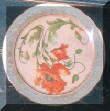 |
April 27, 2005
Q: I am trying to identify this plate and approximate age. Any help is appreciated. Thank
you!!! L. in New York.
A: The
style of your plate is compatible with the styles of the 1920's
and is of American origin. The mark is for Dresden
Pottery of East Liverpool, Ohio, and was used
c.1905-1925. The company used this mark while
under the management of
The Potters Cooperative which
was founded in 1882 and lasted until 1925.
This is the last mark shown for Dresden Pottery. The
factory was originally founded in 1875 by Brunt, Bloor,
and Martin. (Source:
Lehner's Encyclopedia of U. S. Marks on Pottery, Porcelain, and Clay
by Lois Lehner, page 60.)
 |
|
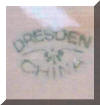 |
| |
|
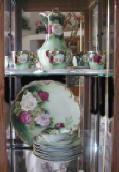 |
April 12, 2005
Q: I am
trying to find out for a friend about this beautiful chocolate set that was
her Mother's. She herself is 80 years old and remembers it being in
the house always and believes it was a wedding gift to her parents in
1920. It consists of a chocolate pot, 5 cups and
saucers, 6 dessert plates, and two nut dishes. All are in perfect
condition.
She may be interested in selling it, and I told her I would try to
find out about it on the internet. Thank you.
L.D., Mesquite, Nevada, for
AH, Las Vegas, Nevada, USA
(She lives in Nevada in the summer and in Vermont in the winter, as
do I.)
A: The
only Royal Munich I've ever had is the one portrait plate,
Item #2085,
which I sold almost as soon as I posted it. Then and now, I've not
been able to identify Royal Munich -- of all the books I have, there
is no mention of Royal Munich at all that I can find.
The best I can determine is that Royal Munich must have been a decorating
studio, possibly in the general area of Germany that produced the popular R.
S. Prussia and related products. Mary Frank Gaston's book on R.
S. Prussia featuring R.S., E.S.,O.S., and C.S., Fourth Series, has a
whole section on "Royal" marks such as Royal Vienna, Royal Berlin, Royal
Coburg, Royal Frankfort, Royal Tillowitz, etc., which were apparently
decorating marks. Royal Munich is possibly in that same category and
just not documented.
The other mark is that of Zeh, Scherzer & Co., of Rehau, Bavaria,
Germany, and is shown in Kovel's Dictionary of Marks, page
225, as first used in c.1880. It appears that
this chocolate set was manufactured by Z. S. & Co.,
(NOT
by an RS Prussia factory)
and then decorated by Royal Munich which was apparently a
decorating studio. Marseille appears to be the name of the
design of the mold. Refer to my December 3, 2004, posting below for a
beautiful plate with the same Z.S. mark and appears to be very similar
except for the decoration.
Since your friend's parents were married in 1920 and received this set as a
wedding gift, it would probably be safe to assume that it was probably "new"
at that time, as in "not yet used." So, saying that it is c.1920
or possibly older would be safe. If gifted in 1920, it would have
actually been manufactured and decorated a few years prior to that, possibly
even before WW I and just not marketed until after the war was over.
It would also have needed time to make its way to the U.S. and into the
hands of the retailer, assuming it was purchased in this country.
Thank you for allowing me to post your pictures and information. Hand
painted items are very desirable and I know others will enjoy seeing this
beautiful set.

|
|
 |
|
 |
|
 |
|
|
 |
April 9, 2005
Q: I have
an oval bowl with a mark I can't locate. It's a circle in
red with Germany around the inside edge and the number 83 in the center.
The bowl also has a large diamond shape formed on the bottom. Can you
help me identify the maker? This was my great grandmother's bowl, and
I'm trying to find the history. My great grandmother was born in the
mid-1800's, and it is my understanding that her parents came over from
Germany in the late 1800's and brought this bowl with them.
Thank you for any help you can provide.
K.H., St. Louis, Missouri, USA
A:
Your bowl is beautiful, and through our e-mails you have confirmed that it
is hand painted which makes it even more special for you. Many of the
older pieces didn't get marked with the manufacturer's name for some reason,
and the circled Germany is not attributed to any particular factory as far
as I can find. Beginning in 1891, the McKinley Tariff Act
required that countries of origin be printed on porcelain coming into this
country. According to Kovel's Dictionary
of Marks, page 229, Germany is known to have started that
practice as early as 1885. Whether or not the 83 in the center of the
German mark on your bowl is for 1883, I don't know. Thanks for sharing
your pictures and information.
 |
|
 |
|
Regarding the diamond design on the bottom, I believe it is nothing more
than part of the design of the mold. I've noticed that many of these
very old German bowls have some sort of an inner rim, possibly intended as
additional support. |
| |
|
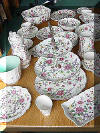 |
April 6, 2005
Q: I am a
Dutch woman and collect James Kent Old Foley
Chinese Rose. I have pieces with several different
kinds of marks, and I have not an idea which one is the oldest. Can
you give me more information? I am interested in the history of
it and hope you can help me. Beforehand, thanks very much.
I studied your website and I give you my compliments. It is fantastic.
Greetings from the Netherlands. I.V.,
Hoofddorp, Holland
A:
Thanks for finding us here in Texas USA all the way from the Netherlands.
I've studied your pictures and marks. You have two basic marks
(1) the ones
with the globe; and (2) the ones
without the globe, with slight variations in each. Some of the
differences I can see in the marks are some variations in the colors and
some have the pattern name and some don't. Sometimes pattern
names just didn't get added to each and every piece. Also, there is
some variation in the wording for the country of origin. I'm showing
all of the marks below.
I
have been able to find only one reference with those two basic marks,
Kovel's Dictionary of Marks,
pages 106 and 195. Kovel's dates both basic marks as beginning
in 1897 and continuing to the present (this book was published in the
1980's). They are identified as being those of James
Kent, Ltd., Stoke, Staffordshire, England. Where in all those
years your dishes would fall, I don't know. The closest I can say is that
the milk pitcher I had by that company (shown
here on my website and identical to your milk pitcher shown at left
except for decoration) was from the
early 1940's -- I know that because we purchased it
from a lady who told me she had purchased it in the early 1940's.
Thanks for your permission to post your question and pictures. If I
learn anything else, I'll update this posting.

|
|
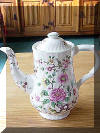 |
|
 |
|
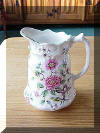 |
|
 |
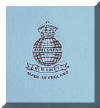 |
 |
If anyone else has any information about this particular pattern or the
marks, please
e-mail us. |
|
 |
 |
 |
 |
|
|
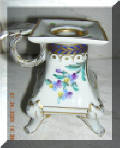 |
February 6, 2005
Q:
Hi: I found your website and have since bookmarked it in my favorites
because it is so informative. I have a Dresden candleholder that is
marked with the letter S in blue
script and then what appears to be the word
Dresden below it. This mark has me stumped.
Another party identified it as a Schumann mark, but I just spent a half hour
going through your website and did not find it. Can you help?
Thanks so much. P.M.,
Sudbury, Massachusetts, USA
A: Your
candleholder is beautiful and no doubt hand painted. The mark is
actually an intertwined S and
P, and your pictures confirmed what I
already knew from your description -- that the mark you described is that of
the Carl Thieme Saxony Porcelain Factory
of Potschappel, Saxony, Germany. There have been others as
well who have mistaken this mark for a Schumann mark, which it is not.
Go to this page of my website and scroll down to the
S's and you'll see examples of
Saxony Porcelain marks that are already
on my website:
Fine Porcelain
There is a good book called Dresden Porcelain
Studios by the Harrans and published by Collector Books.
It can be found on Amazon.com and possibly at your local book
store, as well as on the publisher's website which is
www.collectorbooks.com.
This book has a whole section on Carl
Thieme Saxony Porcelain with pictures and suggested values.
While it doesn't have a candleholder similar to yours, it will still give
you an idea of price ranges, as well as the quality of items produced by
them. Thanks for allowing me to post your pictures and comments.

|
|
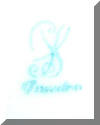 |
| |
|
 |
February 3, 2005
Q: This plate and another one like
it was given to a friend of mine and her sister in 1979 by their great
grandfather. There is writing on the back of one of the plates,
written by the great grandfather in 1979, that says it was 150 years old at
that time. I can't seem to find any information about it. Can
you tell me anything about it? M.W.,
Portsmouth, New Hampshire, USA
A:
The mark on the plate is from Schumann & Schreider,
a porcelain factory in Schwarzenhammer, Bavaria, Germany, who
began business in 1905 and is apparently still in business
today according to my reference book. This mark is shown to have been
used after 1905, but exactly when and for how long is
unclear.
My source is "Marks on German, Bohemian, and
Austrian Porcelain" by Robert Rontgen, pages 110 and 478.
As you can see from this information, the oldest the plate could
possibly be would be 100 years as of this year 2005. You might
take another look at the writing and see if it was intended to say 50 years
old, instead of 150 years. 50 years old in 1979 would have put it back
to 1929, which sounds logical.

|
|
If anyone
else has any information about this particular pattern, please
e-mail us. |
|
 |
| |
|
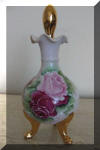 |
January 27, 2005
Q: I have
some Bavaria Schumann Arzberg Germany pieces and I can't seem to find their
exact mark anywhere, including your website which is very informational).
I have no information on these pieces except they were my grandmother's.
They were hand painted by Irene H. Marshall, Whittier, California,
1969. Some have the Schumann mark, and some are unmarked.
Do you know if there was a specific time period when the green Schumann mark
was used? Do you think these were produced around the same time that
they were painted by Irene in 1969? If you have any information about
these pieces, I would greatly appreciate it.
C.D., California, USA.
A: Thank
you for sending the beautiful pictures with the wonderful documentation of the
china painter. The green Schumann
mark is apparently a whiteware mark
for blanks produced for decoration by artists outside the factory. The
unmarked pieces may have been whiteware from other factories besides
Schumann. As to when all the blanks were produced,
it was most likely in the early years of the 1960's -- they may have been in
storage at the factory for a time before being distributed -- it's hard to know
for certain. It would have taken awhile for the blanks to make their
way from Europe to the USA and then into the hands of the china painters,
after which it would take time for the painters to produce their finished
products as
Irene did in 1969. Irene was obviously a very
talented American china painter. Quality pieces by American china
painters can be very desirable and valuable. Here are some references
for more information about American china painting:
"American Painted Porcelain" by
Dorothy Kamm and published by Collector Books
in Paducah,
Kentucky. "Antique
Limoges at Home" by Debby Dubay, and published by
Schiffer Books. You
should be able to find both these books on
Amazon.com or on the publishers' websites:
http://www.schifferbooks.com
http://www.collectorbooks.com Thank you for
sharing this information and allowing me to post it. I am also adding
this whiteware mark to my table of Schumann marks
and am assuming it is from the 1960's.

|
|
 |
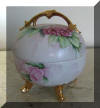 |
 |
 |
 |
 |
| |
|
 |
January 11, 2005
Q:
I have two candelabra that are 21 1/4" tall with a 12"
wingspan. They belonged to my Grandmother who originally came from
Budapest, Hungary. She went often to all areas of Germany and got
these on one of her trips back. They have been carefully packed and
stored for many years and only displayed on festive occasions. They
are majestic pieces and are perfect and flawless -- MINT condition!!
There is a mark underneath, but I have no idea who the maker is. Can
you help me? S.C.H., Celebration, Florida,
USA
A:
Your candelabra are beautiful!! Your Grandmother must
have purchased them between the years of 1967 and 1972
or shortly thereafter. The mark is that of the Von Schierholz
Porcelain Manufactory of Plaue, Thuringia, Germany.
The history of the factory goes back to 1817 and this mark is their
Jubilee mark (150 years) put into use from 1967 until 1972.
My sources of information are the Kovel's
Dictionary of Marks, page 109; and the
Directory of European Porcelain by Danckert, page 367.
It is great that these came from your grandmother and that you know as much
as you do about their line of ownership. Thanks for sharing with us.
 |
|
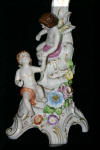 |
|
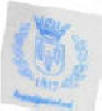 |
| |
|
 |
January 5, 2005
Q: Can you
tell me anything about the manufacturer and date of these beautiful plates
that my husband inherited? Thanks. L.P.,
Long Island, New York.
A:
Information about Edgewood China is apparently nowhere to be
found. In all the books I have, nothing at all about an Edgewood
of any kind. I've even sent out e-mails to a dealer group that I
belong to, and the responses I've received say "never heard of it."
One dealer did suggest that perhaps it may have been a small decorating shop
that decorated blanks from various factories. That sounds reasonable
and the best we have at the moment. I, too, have a plate with
that same mark, and my initial feeling about that one, as well as yours, is
that they are most likely from the 1950's and of American origin -- just my
speculation. Please check back periodically so see if I have posted an
update to this information.

Update: August 17,
2005 "
I, too, have been hunting for information about
Edgewood China with little success. I did find your website
and thought this might be helpful. I have several of these gold
encrusted plates with floral centers that I have been selling for a friend
who is cleaning our her family home, but I discovered they have different
marks on the backs. The first ones I sold had the same mark as that
pictured on your website (see above). The others have a
different mark (see mark at left) and do not include the name
Edgewood. I'm not sure which mark is the oldest, but at least
we know there are two different marks. These plates actually came from
York County, Pennsylvania, from my friend's family, which would date them
back to 1920's or 1930's, or even to her
grandparents from the early 1900's. She has no idea who originally had
them. They've been stored away either in the attic or storage shed for
years and years."
ALS, York County, Pennsylvania.
Update: September 19,
2006 "
I, too, have an Edgewood China plate. The
marking on the back is similar to the first one posted, although it appears
to be gold. The only thing I know about the plate is that it belonged
to my great grandmother who, after immigrating from Poland in the 1890's,
lived in Brooklyn for the remainder of her life until 1957."
LIB, New York, New York.
Update: May 14, 2007
A very nice e-bay seller sent us these pictures which have
been very helpful in learning more about Edgewood. This
Homer Laughlin mark is a
whiteware mark from the
1920's-30's (Source:
Decorative American Pottery Whiteware,
page 131, by Jeanie Klamm Wilby). Notice the
gold Edgewood mark, which appears to be a
decorating mark. This
supports the suggestion at the beginning of this posting on January 5,
2005, that Edgewood China
must have been a small decorating shop that decorated whiteware from various
factories, including whiteware from Homer
Laughlin China Company of West Virginia USA.
"Thank you, Ben, for sending these pictures."
Ben's user name on ebay is the-nook. |
|
 |
|
If anyone out there has
information about Edgewood China, please
e-mail me.
I will, of course, credit you with the contribution and add it to this
posting. |
|
August 17, 2005, Update |
|
 |
|
 |
|
September 19, 2006,
Update |
|
 |
|
 |
|
May 14, 2007,
Update |
|
 |
|
 |
| |
|
 |
December 28, 2004
Q: I would very much appreciate it
if you could give me more information about these pieces; i.e., age and name
of the pattern, etc. These are just a few items from the whole
collection. I have realized that each plate has a different collection
of flowers on them, although in the same style. They have been in our
possession for more than 30 years. The tissue paper they are wrapped
in is off-white and looks old. I also see a small symbol in gold under
the word Dresden and don't know if this means anything. There is also
an alpha-numeric stamped on the bottom of each piece; C5957S.
Would this be a batch mark or date stamp like a hallmark in
gold? L.H., Bedfordshire County,
England.
A:
What you have is from
the Carl Thieme Saxony Porcelain Factory of Potschappel, Saxony, Germany.
Here are links to the Dresden website which has a history of that company as
well as a display of the various marks:
http://www.dresden-porcelain.com/history.htm
http://www.dresden-porcelain.com/trademark.htm
The mark on yours appears to be #6, the one put into use from around the
turn of the 20th Century. As you will see, a form of that mark is
still in use today. However, I did find what is basically your exact
pattern on page 123 in "Dresden
Porcelain Studios" by Jim and Susan Harran and published by
Collector Books (www.collectorbooks.com).
I believe this book can also be found on
Amazon.com.
Their picture is of a Carl Thieme Saxony
Porcelain hand painted tea cup and saucer, with
beautiful florals similar to yours (though not exactly) and the exact same
gold design around the rims as yours. They have dated it as c.1920's
and I believe it is safe to say that yours are most likely from that same
era -- at least pre-WW II.
As to the exact name of the pattern, I can't tell you other than that the
flowers appear to be a version of the popular
Dresden Flowers. Many companies decorated their china with
the Dresden Flowers, but there is usually something else as part of the
pattern name -- for example, Empress Dresden Flowers, Chateau Dresden
Flowers, etc.
You have confirmed for me through our e-mails that yours are also hand
painted. As soon as I saw the mark, I knew they were most
likely hand painted. Hand painted items are always very desirable.
As to the numbers,
the meaning of those seem to vary from manufacturer to manufacturer, and
I've not been able to definitively figure those out on anything I've seen so far. They
could be pattern numbers, lot numbers, batch numbers, even coded year dates
-- I just don't know. The symbol in gold could possibly be the artist's
code/i.d. -- again, I don't know.
Thanks for
allowing me to post your question and pictures and for sharing your story.
 |
|
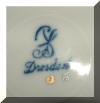 |
|
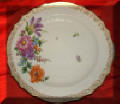 |
|
 |
|
 |
|
 |
|
 |
| |
|
 |
December 28, 2004
Q: I was
wondering if you knew where I could find information about the items in
these pictures. I have a set of six plus Altrohlau tea cups,
saucers, plates, and a serving tray. I also have a cream and
sugar set that is painted the same but is by T & V Limoges.
There is another serving piece that is identical in design but is by
Moschendorf.
The Moschendorf piece has Spichen
signed on the back. The two pieces by T & V Limoges have
M. A. Gott signed on the back. All of the pieces by
Altrohlau have the initials N.R.G. signed on the back.
None of these match any of my relatives, so I'm not sure who these people
were. These have been in the family for quite some time, and I'm
curious about their history. Thank you for any information.
J.M.L., Gobles, Michigan, USA
A:
Thanks for sending
the beautiful pictures. With all the pieces obviously hand painted and
decorated the same, yet each with different names on the backs, these
are all whiteware pieces manufactured by various factories and then hand
painted by various artists. Whiteware was/is produced for decoration
outside the factory -- usually by decorating studios or independent china
painters -- American china painters, for example.
Since none of the signatures match up with any of your family members, then
perhaps the pieces were accumulated by a collector who purchased them
from various independent china painters, probably American China Painters,
who may or may not have known each other -- we have no way of knowing unless
they are listed artists -- I haven't been able to find their names in
anything I have. Whatever the case, they all ended up in the same
collection and you are the fortunate one to now have them.
In my opinion, you
have some wonderful treasures. I love hand painted porcelains, especially
if they are florals and in the soft pinks and blues as are yours. We think
the flower is probably the Desert Rose.
Good quality hand-painted china by American china painters is very
desirable. A good book filled with pictures of beautiful hand-painted
china, as well as suggested values, is "Antique
Limoges at Home" by Debby Dubay, and published by
Schiffer.
As to age, the T & V Limoges France mark is a whiteware mark dated to
c.1892-1907. T & V is for Tresseman and Vogt
who were Limoges decorators and exporters. My source is Mary Frank Gaston's
book "Collector's Encyclopedia of Limoges
Porcelain, Third Edition", pages 288 and 293.
The MZ Altrohlau CM-R mark is dated to 1920-38.
MZ is for Moritz Zdekauer, a banker, who took over a stoneware
factory in Altrohlau, Bohemia, in 1884. The same factory was then acquired
in 1909 by C. M. Hutschenreuther, after which it was officially called
Altrohlauer Porcelain Factory. My source for this is
"Directory of European Porcelain"
by Danckert, pages 15 and 16.
I noticed on the MZ mark that there is a black curve. I believe that
beneath that black curve you would find "Czechoslovakia" which someone
chose to black out. Covering up a word or a mark was not an uncommon
occurrence on whiteware. However, in this particular case, it probably
had something to do with the back and forth history of that part of the
world.
The PM Moschendorf Bavaria mark is that of the Moschendorf
Porcelain Factory who was in business 1878 until c.1945. The closest I
can come to dating this particular mark is c.1904-1938. My
source is "Marks on German, Bohemian, and
Austrian Porcelain" by Robert Rontgen, pages 93 and 419.
An additional book for more information on hand painted porcelains is
"American Painted Porcelain" by
Dorothy Kamm and published by Collector Books
in Paducah,
Kentucky.
You can probably find all of the above books on
Amazon.com or on the publishers' websites:
http://www.schifferbooks.com
http://www.collectorbooks.com
Hope this is helpful. Thanks for allowing me to post your pictures and
questions.
 |
|
 |
|
 |
|
 |
|
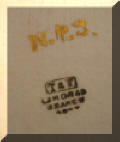 |
|
 |
|
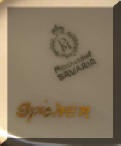 |
| |
|
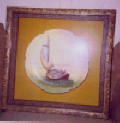
According to page 71 of Gaston's book, George Borgfeldt was a New
York importer with art studios in Europe, including one in
Paris. The studio artists decorated whiteware (undecorated blanks)
produced by Limoges factories and used a combination of transfer designs and
hand painting. Your boat scene is apparently one of the transfer designs
that was then hand painted by Duval
and signed by him/her.
You
have a wonderful family treasure. Thanks for sharing it with us. |
December 21, 2004
Q: I
have a plate, 10" diameter, with scalloped edge. It is a sailboat with
three passengers, green sea, yellow sky, and signed
Duval. The plate has been framed for years.
However, notes on the back of frame indicate Limoges, and in my
Grandmother's writing to her daughter, my Aunt, "My prize possession
-- this plate John Bratcher gave me when you were a little girl."
Aunt Wilma was born in 1911. Any value?
G.H., Ford County, Illinois, USA
A: Your
plate definitely has value. Duval
is a listed Limoges artist, and I found a plate exactly like yours on page
83 of Mary Frank Gaston's Third Edition book on
Limoges Porcelain. If it weren't for the picture showing it
sitting on a plate stand (not framed as yours is), I would think it was the
exact same plate. The one in the book has the Borgfeldt Mark
that is dated 1906-1920 which agrees with your family history
of 1911 or thereabouts when the plate was gifted.
Decorated wares from the Borgfeldt studios, including those decorated
and signed by Duval, are
apparently quite popular. The one likes yours is shown in the Gaston book
in the $325 to $375 range (the book was published in 2000). With the
added family history you have, especially the hand written note on the
backside, that would certainly add some to the value. If I were you, I
would attach an additional note to the back (dated and signed by you)
saying that your Aunt Wilma was born in 1911 since that piece of information
is what narrows down the date as to when it was gifted. Prices shown
in books are intended to give suggested ranges at the time of printing, and
no guarantees are given that those prices would be the ones actually
realized in the market place. Market prices have many variables
causing the prices to possibly be higher or lower than expected. You
can find the Gaston book on
www.amazon.com and also on
www.collectorbooks.com.

|
| |
|
 |
December 16, 2004
Q: Hello.
Thank you for a great website!!!! I've been researching this beautiful
set of Schumann China (Bavaria) and am very interested in any history you
may have on this. My husband just inherited this set, and we will keep
it as a family heirloom and would like to pass any information on to our
kids. His father was in the Air Force in Germany from 1950 to 1953,
and we occasionally tour in Germany, so we have some sentimental ties to the
history of this beautiful set. Thank you for any help you may offer
and for your dedication.
Anonymous by preference.
A:
Thank you for your nice e-mail
and comments about our website. Your beautiful set is yet another
Schumann pattern I've not seen until now. It's nice that yours has the
pattern name "Bouquet"
on it -- so many of them, especially the older pieces, weren't identified at
the time of manufacture, or perhaps just not named at all (I'm not sure
which). As to some history, your set was made by the Carl Schumann
Porcelain Factory in Arzberg, Bavaria, Germany, in business
1881-1994. The US Zone part of the mark and the
fact that those words are in the same style and color as the rest of the
mark (except for Bouquet) make it easy to pinpoint the date of
manufacture as being sometime between 1945-49, the years
the United States occupied a portion of Germany just after World War II.
Notice that "Bouquet"
is different from the rest of the mark and looks like
it was applied with a stamp at a later time -- probably at the time of
decoration by either the Schumann factory or possibly by an outside
decorating studio. Green marks are sometimes an indication of
whiteware (undecorated blanks) produced for decoration outside the factory.
It's also possible that the factory just stored the blanks for a short time
and then decorated them in-house after they decided on a pattern. All
this is just my speculation. You have since told me that
"Bouquet"
is stamped on only two of the pieces which helps to confirm my theory of
after-the-fact decoration and naming of the patterns. Thanks for telling me that and
for allowing me to add your pictures to my
Schumann table of patterns and marks.

|
|
 |
|
 |
|
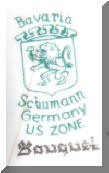 |
| |
|
 |
December 11, 2004
Q: Do you recognize this mark?
I've exhausted all of my good books on marks and looked on the net and no
luck so far. Many thanks!!
D.W., Palm
Beach Gardens, Florida, USA
A:
This appears to be from the
J. Tieles Porcelain Factory of Paris. The triangle mark
is shown on page 355 of the Directory of
European Porcelain by Danckert. There is, however, no
date and no other information included about the factory in this book or any
other books that I have. I haven't been able to
find the top mark at all. If I learn anything else, I'll update this
posting.

|
|
If anyone else out there has information, please
e-mail. |
| |
|
 |
December 9, 2004
Q: I have two sets of china my Dad
brought back from Germany back in the 1940's, and I'm trying to find out
something about them and who made them. He told me he purchased
them directly from the factory in 1946 for his mother and paid $80 back
then. While my father was in Germany, he managed the Palace Hotel and
was therefore able to get directly into the factory to purchase the dishes.
They were purchased new, but the design was possibly one of the older styles
they had. The color of the mark is green.
G.D. of Wadsworth, Illinois, USA
A: What you have is another one of the many patterns produced by the Carl Schumann Porcelain
Factory that operated in Arzberg, Bavaria, Germany, 1881-1994.
Unfortunately, the names of many of the patterns are unknown due to records that
were destroyed in two world wars. It's also possible that some of them
were never officially named. Even though your father purchased them
new in
1946, I believe, based on the mark, they may have actually been
manufactured much earlier and just not put on the market until after the
war. They were probably safely stored away during the war years.
Thanks for allowing me to add your pictures to my
table of patterns and marks for the Schumann factory.
 |
|
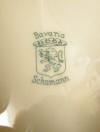 |
| |
|
 |
December 5, 1004
Q:
I recently inherited from my
grandmother this pair of Von Schierholz candelabra and haven't been able to
find much information on them. Do you have any idea as to how old they
are? They are 22 inches tall and in flawless condition with no chips,
cracks, or scratches at all.
A.G., Bethesda,
Maryland, USA
A:
Your candelabra are
beautiful and were obviously well-cared for through the years from the way
you have described them. They
were made by C. G. Schierholz & Sons
of Plaue, Thuringia, Germany. The markings are most like the ones
shown in reference books as being used between the years of
1914-1930's (Source: Dresden
Porcelain Studios by Harrans, page 180). The
word Handmalerei is German for hand painted. You have a
wonderful family treasure from your grandmother. Thanks for finding us
and sharing your pictures.

|
|
 |
|
  |
| |
|
 |
December 3, 2004
Q:
I was just wondering if you had
ever come across a plate like this one. Do you know anything about it
and its year of manufacture? I found it at a garage sale. It is
6 3/4" diameter and in excellent condition with no chips, cracks, crazing,
or repairs. The Orchids are transfers, not hand painted. Thanks.
J.D. of Springfield, Missouri, USA
A: Your plate is beautiful.
No, I haven't seen one exactly like this one. The mark is that of
Zeh, Scherzer & Co., of Rehau, Bavaria, Germany. Reference books
show this green underglaze mark as being used as
early as 1880, but no ending date is given. Whether or
not your plate goes back that far, there is no way to know. My guess
is that it easily goes back to at least the very early part of the 20th
Century. My sources for the dates are page 195 of
Kovel's and page 292 of
Rontgen's. Thanks for
sharing your pictures with us.
 May 3, 2005 Update:
At this point, it appears that Marseille is the name of
the design of the mold. Refer to my May 3 posting above for the Royal
Munich Chocolate set. Same Z.S. mark and similar shaped mold, but
different decoration.

|
|
 |
|
 |
|
|
 |
November 24, 2004
Q: Why is the mark on my Schumann plate different from those shown on
your site? Ignez, Key Biscayne, Florida, USA
A: Products produced by the Carl Schumann Porcelain Factory of Arzberg, Bavaria, Germany
(1881-1994) have quite an assortment of marks, including the Royal
Dresdner Art mark that you have on your plate (notice the cursive Carl
Schumann name as part of the mark). This mark is shown in
the reference books as being for the Schumann China Corporation of New York
City which served as the U. S. distributor of Carl Schumann products between the years of
1931-1941. My reference source is Rontgen's
Marks on German, Bohemian, and Austrian Porcelain,
pages 171 and 456. Click here for more
Schumann information and to view my table of marks and patterns.
With your permission, I am adding this plate and mark to my Schumann table.
Thanks for finding us.

|
|
 |
| |
|
 |
November 18, 2004
Q:
I hope you can help me, as
you're one of the very few I've seen on the internet who have Von Schierholz.
I have two small Von Schierholz swans and one large swan, all with painted
roses on their wings. I've tried almost everywhere and found Von
Schierholz, but never these swans. Can you tell me if these appear to
be authentic and can you tell me more about them? They've been passed
down in my family from my great grandmother who lived from 1899 to 1990.
She lived all of her adult life in San Francisco and to my knowledge didn't
travel much. We speculate she purchased them in San Francisco or
perhaps by mail order.
K.J., Apple Valley,
Southern California, USA.
A: Yours are the first
Schierholz swans I've ever seen like this. I've just spent some time
flipping through several of my books and find nothing like them. The
marks do look authentic and are like those Schierholz marks used
1914-1930's according to various
references. I'm keeping your e-mails and posting this information
hoping that someone out there might recognize them and
e-mail me with more information.
Please check back periodically for any updates which will be posted here.
Thanks for finding us.
 |
|
 |
| |
|
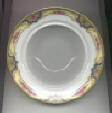 |
November 11, 2004
Q: My mother-in-law left me an
eight place setting of dinnerware. The mark on the bottom of the
pieces has the Elite Works Limoges France green mark. The other
stamp is red. She said that her father bought these in Massachusetts
in probably the early 1920's. Thanks for any help in identifying
these. P. (location unknown).
A: The marks are those of
Bawo & Dotter of New York who were importers beginning in the
1860's and by the
1870's had established their own decorating studio called
Elite Works. They decorated whiteware made by other factories.
By the 1890's, they were doing their own
manufacturing as well as decorating. The green mark is a
manufacturing whiteware mark dated
c.1920-1932. The red mark is a decorating
mark dated c.1900-1914. Those
general dates agree with what you know of the history of your china as
probably having been purchased in the early 1920's. Since your china
has both of these marks, it appears that the green mark was probably used
earlier than 1920 or perhaps the red mark used later than 1914 since the
manufacturing would have come first and then the decorating after that. My source of information is Mary Frank
Gaston's Third Edition book on Limoges Porcelain. In
fact, her book has a picture of your exact pattern on page 54
and shows a cup and saucer that is priced at $55 to $65. You can find
her books on Amazon and also possibly in your local library or
books stores, as well as on her publisher's website which is
www.collectorbooks.com For
prices on other pieces in your set, try searching using the key words
Bawo and Dotter, and you'll come up with quite a list of resources.
Hope this information is helpful to you.
 |
|
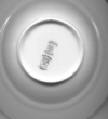 |
| |
|
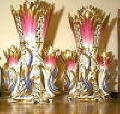 |
October 21, 2004
Q:
I found your website and
hope to learn something about these vases which belonged to my aunt.
She was born in 1921 and served as a nurse in World War II. She
requested overseas duty and was stationed in Naples, Italy. At the
war's end, she was killed during a riot. When her remains were shipped
home to the states, her belongings were packed up and sent as well.
These vases were among them. We assume she purchased them while
stationed in Italy between 1945-1946. They have a marking on the
bottom which appears to be CF and then underneath that VII.
Thanks for any help.
C.P., Ozark Mountains
Region, USA.
A:
Your beautiful pair of vases
appear to be from Christian Fischer who operated a factory in Pirkenhammer,
Bohemia. The incised CF mark is one used
1846-57, according to pages
365 and 366 of the Directory of European
Porcelain by Ludwig Danckert. For more information
about the Pirkenhammer factory, go to
www.pirken-hammer.com where you'll find links to their hallmarks and
history. Thank you for being willing to share your beloved aunt's
story with us and allowing us to post it.
 |
|
 |
| |
|
 |
October 21, 2004
Q:
I have been given two
decorative plates with pictures of small cherubs which are not hand painted,
but are transfers. On the back are markings with the words Victoria
Carlsbad Austria. Are these reproductions? Can you date them
approximately? A.L., Ballycastle, Co. Antrim,
N. Ireland.
A:
That appears to be a good
mark from the Victoria Porcelain Factory of Altrohlau, Austria, and dates to
1891-1918 (Source:
Page 59 of
Kovel's and page 17 of
Dictionary
of European Porcelain).
See our Glossary
under Altrohlau, Bohemia, and Czech Republic for
some historical information about this region. It's
a beautiful plate. Cherubs are always quite popular, even if not hand
painted. Everything I've had with cherubs has sold almost immediately.
Thanks for finding us all the way from Ireland.
 |
|
 |
| |
Return to Top of Page
|
